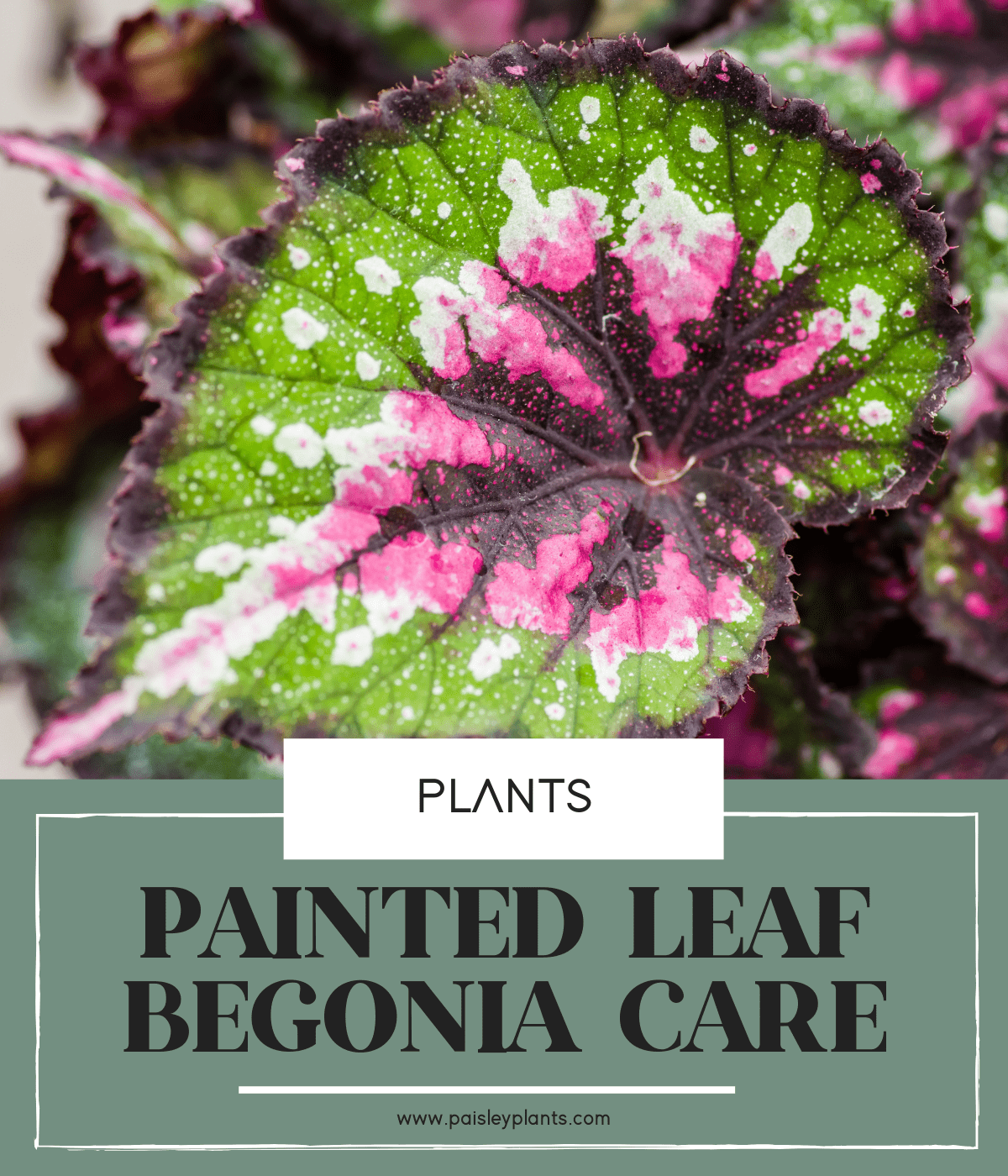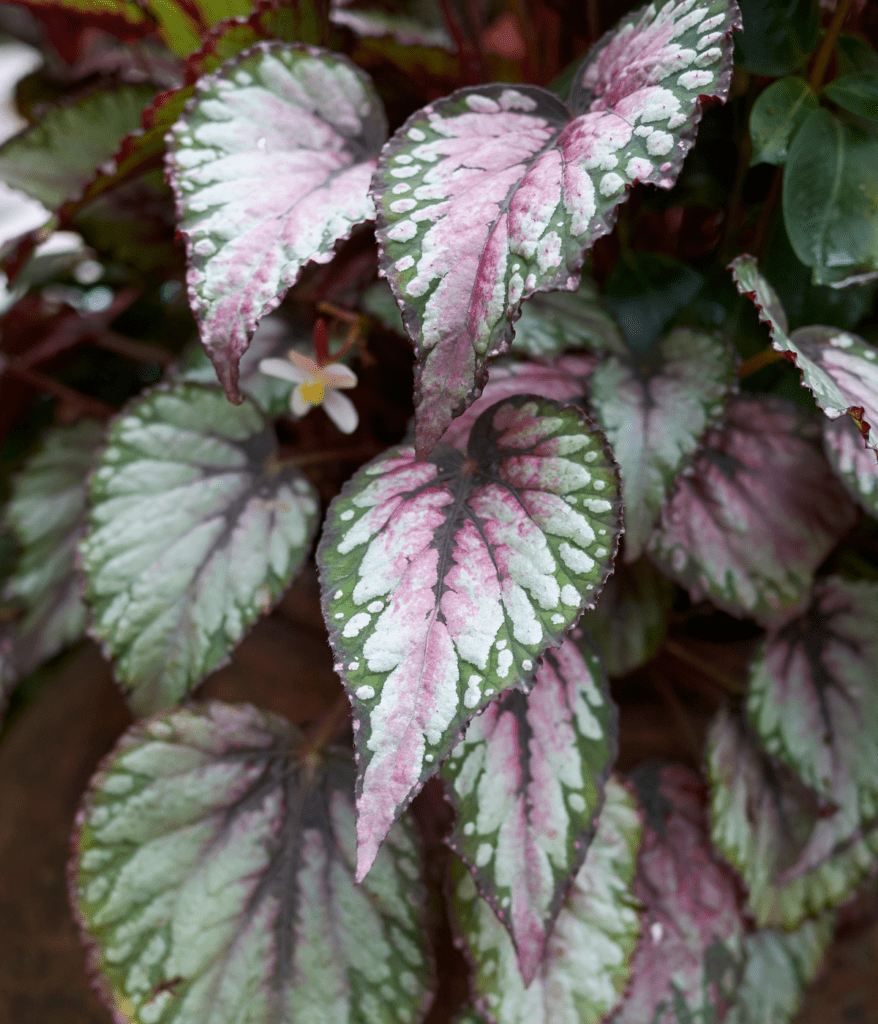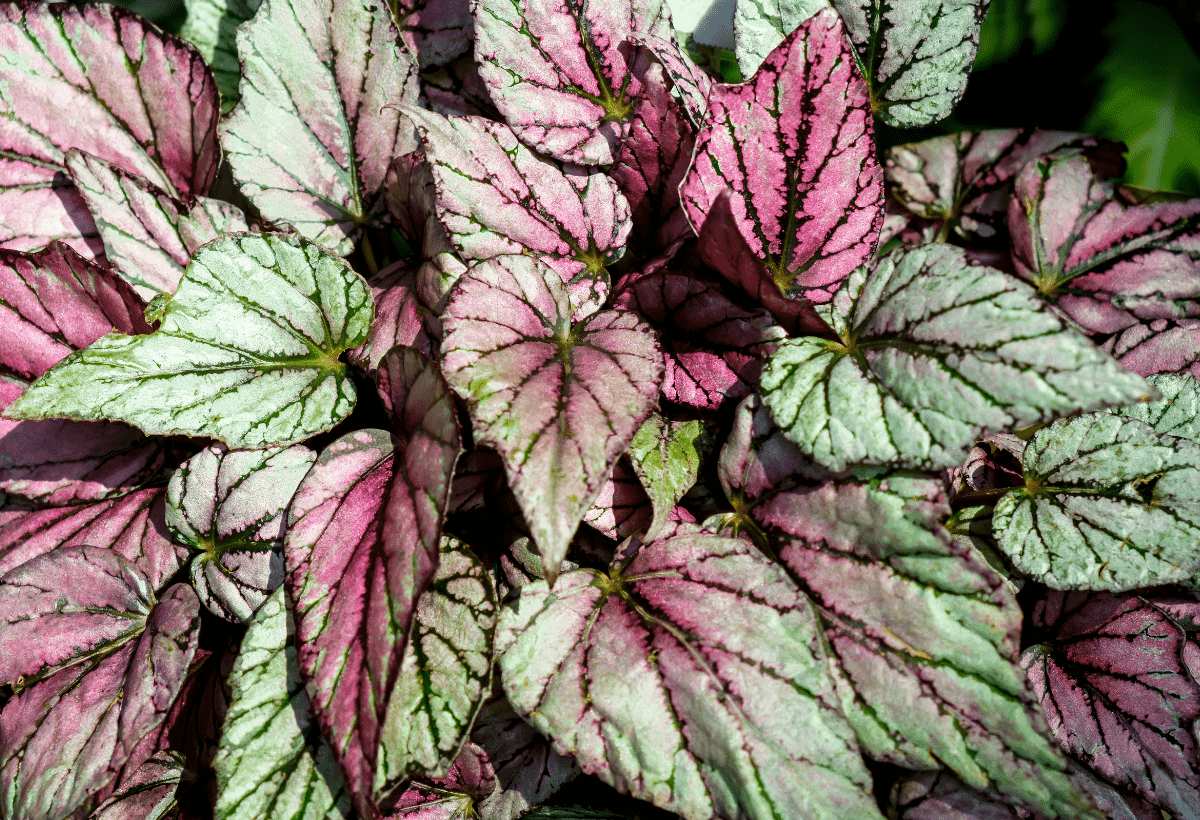The painted leaf begonia is often considered to be a tricky plant to care for, but I disagree! The vibrant leaf color of the begonia is dependent on the quality of care it receives.
However, with this ultimate care guide, you can easily care for this popular houseplant. Read on for the best way to care for your painted leaf begonia plants.

This post includes affiliate links.
Table of Contents
Painted Leaf Begonia Background & History
Known in the botanical world as the Begonia rex-cultorum, the painted-leaf begonia is certain to turn heads. Also known by its other common names, the rex begonia, fancy-leaf begonia and king begonia, the painted leaf begonia plant is identifiable by its vibrant leaves which range in a multitude of colors.
These colors include green, red, silver, and even purple! While these plants do produce small flowers, they are primarily grown exclusively for their beautiful large leaves.
The begonia rex plants are native to a variety of locations spread across south Asia, including India, China, and Vietnam. As semi-tropical plants, the rex begonia enjoys moderately warm temperatures and humid air conditions.
Unfortunately for pet owners, the painted leaf begonia is toxic to animals, so it is best to exercise extreme caution with this plant.
Painted Leaf Begonia Care

Sun & Light
The painted leaf begonia enjoys living in bright, indirect sunlight. Unlike many other members of the begonia, this particular variety is not an aggressive bloomer, therefore it can tolerate less light.
You can also opt to use artificial light for your rex begonia. Fluorescent lights are a great option for giving your indoor plants enough light especially in those darker winter months.
Water
Painted leaf begonias enjoy a consistently moist soil. However, it is also important to ensure that you are not overwatering your plant. Overwatering your beautiful plant could cause root rot. To avoid overwatering, allow the soil surface to dry before rehydrating your plant. Don’t wait until the soil is entirely dry, as this can cause wilting.
Soil Type
The ideal type of soil for a painted leaf begonia is a soil that is airy, light, and well-draining. Look for a soil that leans towards acidic, somewhere between 5.7 to 6.2 in pH.
Fertilizer
Fertilizer should only be applied during your begonia’s growing season (during spring and summer), and completely ceased during the fall and winter when your plant is dormant.
Apply a diluted fertilizer to your plant. You can dilute your fertilizer at half strength and only apply it every two weeks, or dilute to a quarter strength and apply every week.
Temperature & Humidity
Painted leaf begonias enjoy moderate temperatures which can easily be sustained in a home environment. The ideal air temperature range for a begonia is between 60 to 70° F.
In addition, these plants enjoy high humidity (around 50% humidity). I would recommend getting a humidity meter to check how humid your home environment is.
If you need a more humid environment, you can opt to use an electric humidifier or a plant mister.
Pruning
In order to encourage full growth in your rex begonia, it is recommended to prune your plant as needed. Pruning any dead or damaged leaves will help redirect your plant’s energy towards developing new growth, rather than trying tor revive dead foliage.
Always remember to use sharp, sterilized scissors to prune your plant. Taking the extra few seconds to wipe your equipment down with rubbing alcohol will prevent spreading possible bacteria and diseases to your plant.
Choosing a Pot & Repotting
Rex begonias grow a shallow rhizome (a fibrous root, as opposed to a network of small, thin roots). For this reason, they enjoy large and shallow pots; this will allow the rhizome to spread out. As long as this rhizome has room to spread and grow, the begonia will be happy in its pot.
When the rhizome starts to grow and touch the edges of the pot, it is time to size up. When you size up to a larger container it’s a good idea to make sure the soil is lightly moist to mitigate the risk of transplant shock.

How to Propagate
Painted leaf begonias can be propagated a number of ways, but propagating via stem cuttings is one of the easiest and most straightforward way to propagate. Follow these simple steps to make your rex begonia multiply.
- Take mature leaf cuttings from your begonia plant with the stem included. The stem should be at least 2 to 3 inches in length. Make sure your cutting is completely healthy and damage-free.
- Dip the cut-end of the stem in rooting hormone powder, this will help increase the odds of your cutting developing roots.
- Bury your stem cutting in a potting mix that includes both peat moss and perlite, making sure that the leaves are above ground for air circulation.
- Keep the soil consistently moist, but never soaking. Place your pot in a location that receives bright, indirect light and is between 75 to 78° F.
- It takes roughly one month for rooting to occur in your stem cutting. To check for rooting, give your stem a gentle tug. If you’re met with any resistance, then this is a good sign that your stem cutting has established itself.
- When the stem cutting has begun to grow 2 to 3 new leaves, it is time to transfer your cutting into a full-sized container. Care for your plant as you normally would care for a painted leaf begonia.
Common Pests
Mealybugs
Mealybugs are soft-bodied, wingless insects that are a downright nuisance to your garden. The most common sign of mealybugs are the cotton-like residue they tend to leave behind.
While mealybugs are not a welcome member of the garden, they are very easy to get rid of. Try wiping away the cotton residue with a swab soaked in rubbing alcohol.
You can also prevent mealybugs by treating your plant with an insecticidal soap or a horticultural oil.
Common Diseases
Powdery Mildew
Powdery mildew is a possible disease you might encounter with owning rex begonia plants. Powdery mildew gets its name from the white, powder-like fungus that grows on the foliage of your plant. It sort of looks like a white or gray mold.
It is very easy for this fungus to spread, so early detection is key to control it. If you notice a powdery mildew on your plant, immediately prune away any signs of fungus and destroy the affected foliage.
Powdery mildew is primarily caused by wet foliage combined with a lack of air circulation. Prevent powdery mildew by watering your plant at the base and avoid overhead watering.
If you use a plant mister, avoid getting the leaves saturated with water. In addition, try not to crowd your plants together, allowing each one their own personal space to promote air circulation.
FAQ
Painted leaf begonias are considered to be a medium-paced grower. As a result, they do not require repotting very often. With the right pot size, they could probably go their whole life without needed to be repotted.
Painted leaf begonias are a perennial plant, meaning that they will live for multiple growth cycles, as long as they are carted for properly. With the utmost care, your painted leaf begonia will live for a few years.
Before your plant begins to die off, I highly recommend copying your rex begonia via propagation while your plant while it is still healthy, that way you can continue on the longevity of your plant.
Oftentimes, cold temperatures can cause the painted leaf begonia to slow its growth. Make sure that your plant is in a location with a consistent temperature between 60° to 70° F.
Try to avoid placing your begonia in a location that is too cold such as near an air conditioning vent or a drafty window.
It’s hard to pinpoint exactly why painted leaf begonias start to wilt, as there could be multiple reasons. First, I suggest checking out your plant for any obvious signs of a pest infestation. If your plant is clear of pests, here are other suggestions as to why your plant is wilting.
1. Soil is too dry or too moist
2. The soil needs more drainage – in this case, work in a little perlite to your potting mix. Also make sure your pot has a drainage hole.
3. The plant requires more light (though make sure to keep it indirect)
4. The humidity levels needs to be increased.
Where to Buy
- Local nursery
- Etsy
Despite having a reputation as a finicky house plant to care for, I find that the painted leaf begonia is quite straightforward as long as you are educated and prepared on how to care for them.
The rex begonia’s signature hues are dependent on meticulous care, and with this ultimate care guide, I hope you’ll put your best foot forward when it comes to housing this unique beauty!
Find more plant care here:

